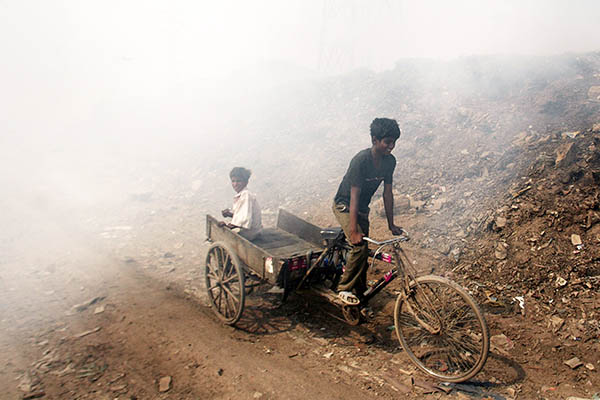State air monitoring center disputes WHO report claiming New Delhi has dirtiest atmosphere in the world.
India’s state air monitoring center made a rare admission Thursday that pollution in New Delhi was comparable with Beijing, but disputed a World Health Organization (WHO) finding that the Indian capital had the dirtiest atmosphere in the world.
A study of 1,600 cities across 91 countries released on Wednesday by the WHO showed Delhi had the world’s highest annual average concentration of small airborne particles known as PM2.5 of 153. These extremely fine particles of less than 2.5 micrometers in diameter are linked with increased rates of chronic bronchitis, lung cancer and heart disease as they penetrate deep into the lungs and can pass into the bloodstream.
Indian officials in the past have bristled at research showing the capital as worse than Beijing where thick smog has triggered public health warnings and public concern that are mostly absent in New Delhi. “If we compare yearly averages for each year from 2011-2014 then both cities [New Delhi and Beijing] are almost comparable,” Gufran Beig from India’s state-run System of Air Quality Weather Forecasting and Research (SAFAR) acknowledged in an email.
He disputed the figure cited by the WHO for PM2.5 in New Delhi, however, saying it should have been in the range of 110-120 micrograms per cubic meter instead of 153.
Beijing’s was underestimated at 56, he said, and should have been double this according to an analysis of readings given out by the U.S. embassy in the city.
“Delhi’s air quality is better than Beijing in summer and much better in monsoon season,” he added. “It is winter pollution in Delhi and sudden spikes which is quite high as compared to Beijing, triggered by meteorology.” Beig maintained that the WHO figures contained in a searchable database released on Wednesday were biased and misleading.
But even with an annual average PM2.5 reading of 110-120, New Delhi would still be among the world’s most polluted cities, if not the outright worst.
Rivals would be Karachi with an annual reading of 117, while the regional Indian cities of Gwalior, Patna and Raipur reported 144, 149 and 134 respectively. By comparison, London had an annual PM2.5 reading of 16.
“The latest urban air quality database released by the World Health Organization reconfirms that most Indian cities are becoming death traps because of very high air pollution levels,” said Indian campaign group the Center for Science and Environment. It said that 13 of the 20 most polluted cities in the world were in India.
The small particles blighting the air of New Delhi and other major developing cities around the world are often dust from construction sites, pollution from diesel engines or industrial emissions. The Indian capital also suffers from atmospheric dust blown in from the deserts of the western state of Rajasthan, as well as pollution from open fires lit by the urban poor to keep warm in winter or to cook food.
While Delhi ranked as worst on the PM2.5 scale in the WTO data, measurements of larger PM10 particles showed others as far more polluted. Peshawar and Rawalpindi in Pakistan trumped all other cities with readings of 540 and 448 respectively.
WHO says concentrations of PM10 particles should remain below 20 micrograms per cubic meter, averaged out over the year.
Delhi has had its air quality under scrutiny for some time now with research by Yale University scientists in January this year also suggesting it was worse than Beijing. A World Bank report last year that surveyed 132 countries ranked India 126th for environmental performance and last for air pollution.
The WHO stressed that its new air pollution database, which relies mainly on data gathered by the cities themselves, did not aim to rank cities, pointing out that “some of the worst ones … are not collecting data regularly.”

